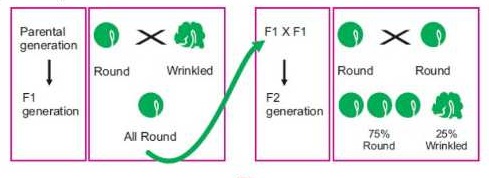Q.9 Define and Explain Mendel’s law of segregation.
Answer:
Definition
In each organism, genes are present in pairs. During gamete formation the genes (alleles) of each pair segregate from each other and each gamete receives one gene from the pair. When gametes of male and female parents unite, the resulting offspring again gets the genes in pairs. This is called as Mendel’s law of segregation.
Explanation
Seed shape
Mendel studied the inheritance of seed shape first. Seed shape is a trait, like other traits in pea plant, which has two distinct forms
1. Round seed shape
2. Wrinkled seed shape
Monohybrid cross
A cross in which only one trait is studied at a time is called as monohybrid cross.
P1 Generation
The parental generation is denoted as P1 generation. Mendel crossed true breeding round seeded plant with true breeding wrinkled seeded plant.
F1 Generation
The offspring of P1 generation are called as F1 generation (first filial).
Dominant trait
The trait which appear in F1 generation is called as dominant trait.
Recessive trait
The trait which does not appear in F1 generation is called as recessive trait.
So Mendel declared the trait round seeds as dominant while wrinkled seeds as recessive trait.”
Self-fertilization / F2 Generation
The offspring of Pl generation are called as F1 generation are called as F1 generation. Later on, Mendel planted F1 seeds and allowed new plants to self-fertilize. As a result, he got 7324 seeds out of which 5474 round and 1850 wrinkled.

Phenotypic Ratio
In F2 seeds, phenotypic ratio would be 3 round: 1 wrinkled
Height
Mendel also studied inheritance of height in pea plant and he got same results.
When true breeding tall plants were crossed with true breeding short plants, all offsprings of F1 generation were tall i.e. Tallness is dominant trait. When members of F1 generation were-self fertilized, Mendel got ratio of tall to short plants in F2 as 3:1.
Discrete factors
Mendel concluded that the traits under study were controlled by discrete factors which are no called as genes.
![]()